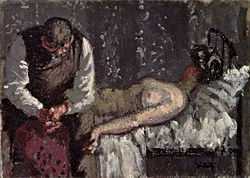The Camden Town Murder

The Camden Town Murder is a title given to a group of four paintings by Walter Sickert painted in 1908. The paintings have specific titles, such as the problem picture What Shall We Do for the Rent or What Shall We Do to Pay the Rent.[1][2]
The title of the group refers to the "Camden Town Murder" case of 1907.[3] On 11 September Emily Dimmock, a part-time prostitute cheating on her partner, was murdered in her home at Agar Grove (then St Paul's Road), Camden, having gone there from The Eagle public house, Royal College Street. After sex, the man had slit her throat open while she was asleep, then left in the morning.[1] The murder became an ongoing source of prurient sensationalism in the press.[1] For several years Sickert had already been painting lugubrious female nudes on beds, and continued to do so, deliberately challenging the conventional approach to life painting—"The modern flood of representations of vacuous images dignified by the name of 'the nude' represents an artistic and intellectual bankruptcy"—giving four of them, which included a male figure, the title, The Camden Town Murder, and causing a controversy, which ensured attention for his work.[1] These paintings do not show violence, however, but a sad thoughtfulness, explained by the fact that three of them were originally exhibited with completely different titles, one more appropriately being What Shall We Do for the Rent?, and the first in the series, Summer Afternoon. Sickert has been named as the serial murderer "Jack the Ripper" by Patricia Cornwell and others.[1]
References
- ↑ 1.0 1.1 1.2 1.3 1.4 Januszczak, Waldemar. "Walter Sickert - murderous monster or sly self-promoter?" The Times, 4 November 2007. Retrieved 13 September 2008.
- ↑ "The Camden Town Murder", Fisher Fine Arts Library Image Collection. Retrieved 13 September 2008.
- ↑ Wendy Baron, Sickert: paintings and drawings, Yale University Press, 2006, ISBN 0-300-11129-0, p.73
Further reading
- Wright, Barnaby, et al., Walter Sickert: The Camden Town Nudes, The Courtauld Gallery, London, 2007. ISBN 978-1-903470-59-6
External links